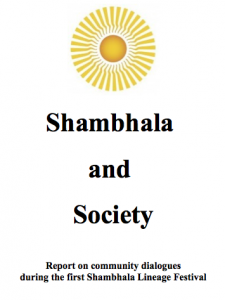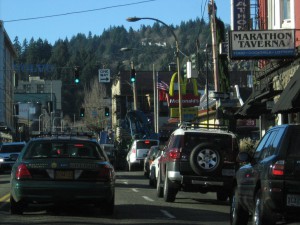Tuesday
Featured Stories, Shambhala News ServiceShambhala and Society Report
 Today we publish a new report, Shambhala and Society based on discussions at 69 Shambhala Centers and Groups around the world. The report covers kindness and unkindness in Shambhala, as well as what people are doing to bring Shambhala vision into the world around them. No such report on this scale has ever been compiled before.
Today we publish a new report, Shambhala and Society based on discussions at 69 Shambhala Centers and Groups around the world. The report covers kindness and unkindness in Shambhala, as well as what people are doing to bring Shambhala vision into the world around them. No such report on this scale has ever been compiled before.
Each day from now until Shambhala Day, you can view direct quotes from this report as they will be posted on President Reoch’s blog: From Our President. This past weekend, President Reoch made a film about this report at the Imperial War Museum in London and the Dalai Lama’s Peace Garden; click here to view this video.
“The world is ready…”
Hundreds of Shambhala practitioners participated in a global series of discussions on Shambhala and Society during the first Shambhala Lineage Festival that occurred last September, 2011.
“People are really desperate for the kind of values that we emphasize and help people cultivate,” said one of the participants. “I think the world is ready for Shambhala leaders to come forward and be active in public discourse, provide public leadership and hope. It’s time to ‘come out of the closet’ about our values – because the time is right, and people of many backgrounds will be interested in what we have to offer.”
During the festival many Shambhala centers and groups devoted time to contemplating and discussing two related themes: Shambhala as a society itself, and the role that Shambhalians are playing in the larger society around them.
Previously, no comprehensive survey had been conducted that would tell us how members of Shambhala were engaging with the society around them. Thus, the reports from the community dialogues during the Shambhala Lineage Festival give us a glimpse into this fascinating (and often under-reported) truth about Shambhala’s people and what they are doing.
A total of 51 centers and groups (of the 69 who reported) sent in numerical listings of the various fields in which participants said they were bringing their own experience of Shambhala teachings and practices. Those 51 centers and groups represent approximately one quarter of all Shambhala centers and groups worldwide, located in Africa, Australasia, Europe, North America and Latin America.
The overwhelming fact that stands out from the reports sent in from all those discussions is that the vast majority indicated some form of social engagement through the way in which they are bringing the Shambhala teachings and practices into their lives and work. Following is the list of the top ten fields of engagement that emerged from the reports:
1. Non-profit work
Includes volunteering, helping charities and not-for profit organizations, being a donor or supporter. This includes those involved in international development work or other kinds of service.
2. Family care
Includes parenting of children and young people, as well as caring for other family members and the elderly.
3. Education
This includes all forms of involvement in the field of education, including all levels of teachers and students, and all levels of education.
4. Arts
This includes all kinds of artistic endeavour in all media, as well as being a teacher or student of any art.
5. Politics
This includes a wide range of involvement, from participation in political parties, to other forms of political activism, including doing one’s best to be well informed about current political events.
6. Environmental engagement
This includes involvement in ecological and environmental issues, “living green”, as well as involvement in agriculture, farming and gardening.
7. Health care
This includes all forms of health care, including mental health care and palliative care. It also includes those involved in caring for the health and well being of animals.
8. Economics and business
This includes the fields of finance, a wide range of business activities and entrepreneurship.
9. Social work
This includes clinical social work, caring for people with disabilities and special needs, working in prisons and community building.
10. Communications
This includes working in the fields of journalism, publishing and media (including digital media and social networking), entertainment and hospitality.
Participants were asked to contemplate a time when they had a direct experience of being in a culture of kindness in Shambhala and what it was that made them experience that kindness.
“In a squad meeting I felt naked, awkward and communicated it directly,” said one of the participants. “Immediately other people responded, not in a sentimental way, but in a real touching and genuine way. For me this is the enlightened social mechanism. If you are brave (and slowed down) enough to communicate from your open heart, it invites kindness.”
“I was experiencing a toxicity in life, which I associated with New York City,” said another participant. “I thought the city made me this way and other people seemed to agree with me. I found Shambhala and checked out the center. It blew me away – people made eye contact with me, they smiled, they came up and said thank you. I would work there on Sundays just because I had experienced so much love and appreciation for just being. I’d never felt that before.”
Next, people were asked to contemplate a time when they felt they were definitely not part of a culture of kindness in Shambhala — and what made them feel this way. They were asked: if you were a leader with all powers needed, what would you do to make sure others did not have that experience?
Sangha gossip was one of the concerns that came up. “Side talk about a third person is very painful to the third party and is an act of cowardice,” said one participant. “If I were a leader, I would (perhaps in a statement of ethics) communicate the view that this is not what we’re about. I would create a culture of, and encourage, direct and authentic communication so that when you have a problem with someone, you talk with them directly.”
One participant talked about an experience of overhearing a senior teacher making sexist and homophobic remarks. The student, with the support of another teacher involved in diversity in Shambhala, had the opportunity to confront the teacher in a heartfelt way and believes that real understanding and growth came from the encounter. Although it was a very painful experience, she felt there was nevertheless a space for genuine communication.
“I am black and Shambhala is very white,” said one of our members. “Every time I go to another center, I have to justify myself, and it feels like I have a barrage of questions about who I am, who I know, do I have the right credentials…”
 Shambhala in the world around us
Shambhala in the world around us
Sometimes we may think that Shambhala is not doing anything in the world around us. But in fact, many Shambhalians are engaged in all kinds of social, ecological, and other activities that are part of creating enlightened society. The final part of the discussion was on the theme: “What are we Shambhalians doing in the society around us?”
“I work in the poorest community in the School District and the challenges are enormous,” said a teacher. “I love these kids, and my work. This is my way of living the vision of an enlightened society. This is my path, and it is tremendously rewarding work. I teach math, love, and perseverance.”
“I am the editor of a newspaper sold and produced by our city’s homeless community,” explained another participant. “I think Shambhala is making me a more patient and mindful editor and journalist. Our humble office is always filled with homeless vendors and writers, as well as college interns and other volunteers. They make it a challenging and yet a beautiful place to practice and be reminded of loving kindness every minute of every day.”
People were clearly inspired by taking the time to contemplate these issues and share their life experience with others. One person spoke for many when she said: “There are many groups in line with Shambhala vision who are doing things in line with our principles. We should reach out more.”
~~
The full report is available for viewing and can be found by clicking here.
To read the daily quotes from President Reoch’s report, visit his blog: From Our President.



















